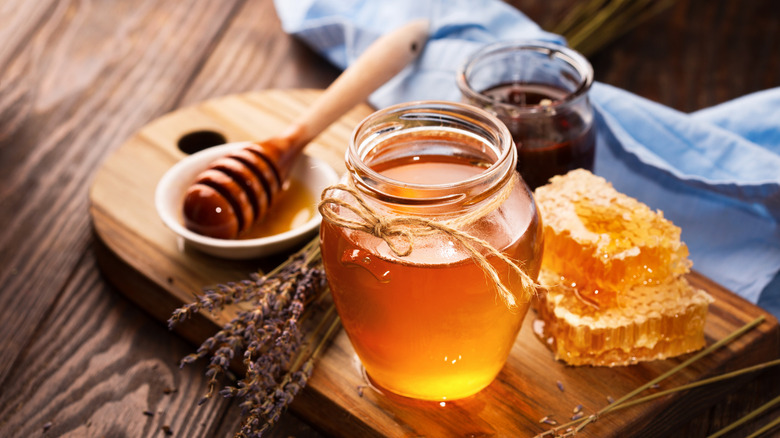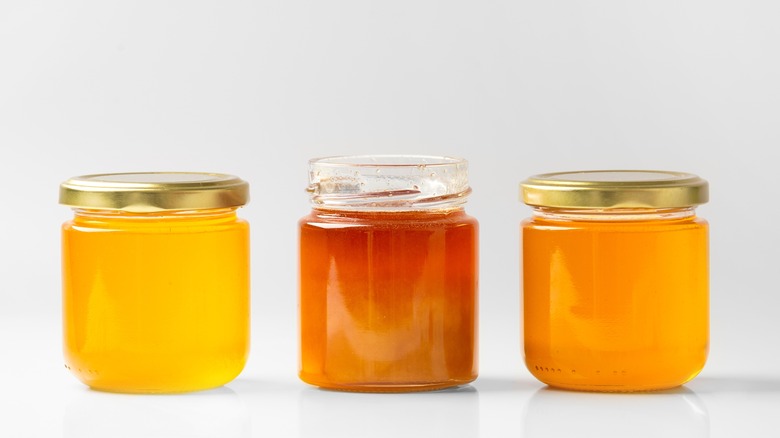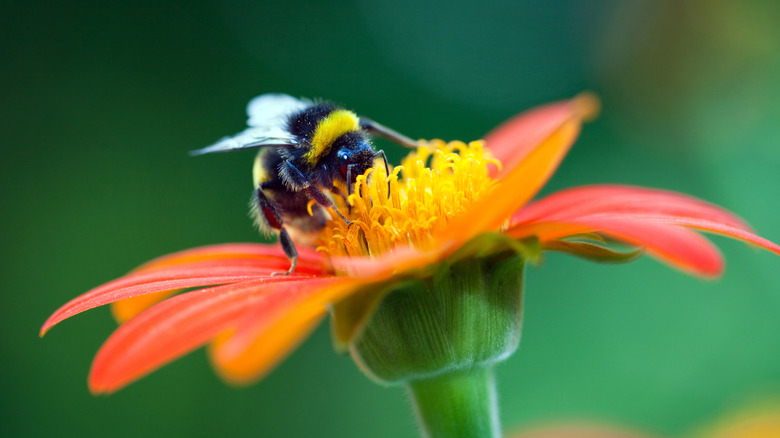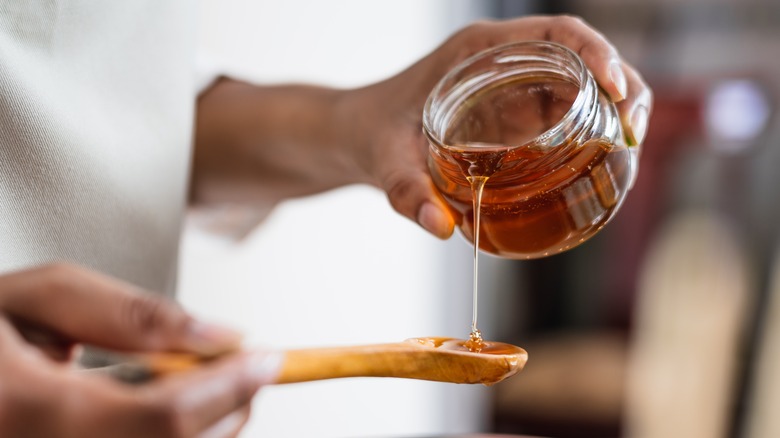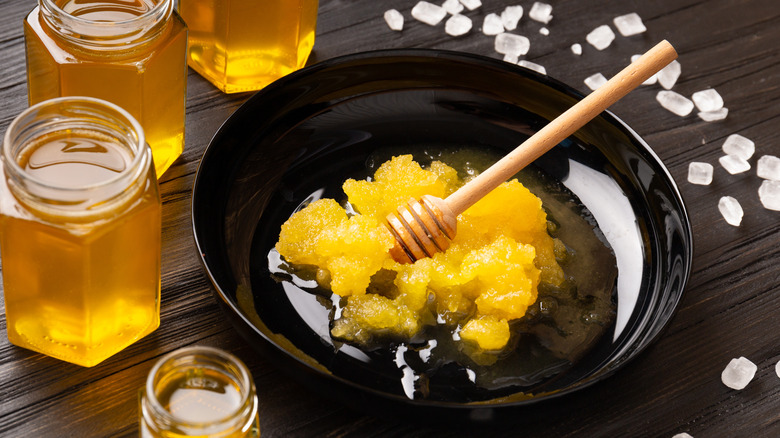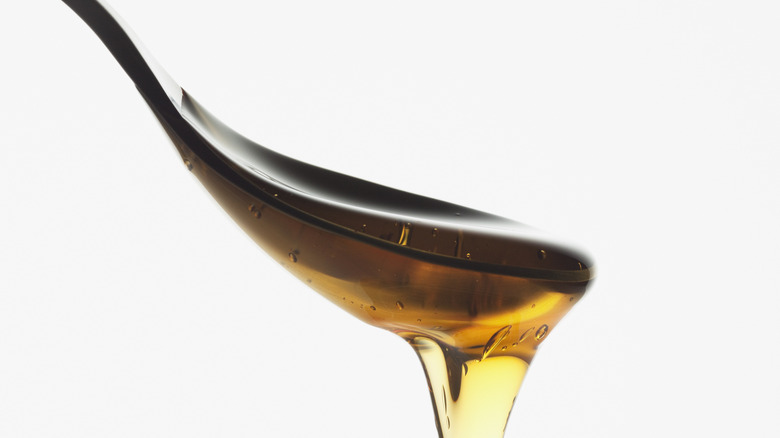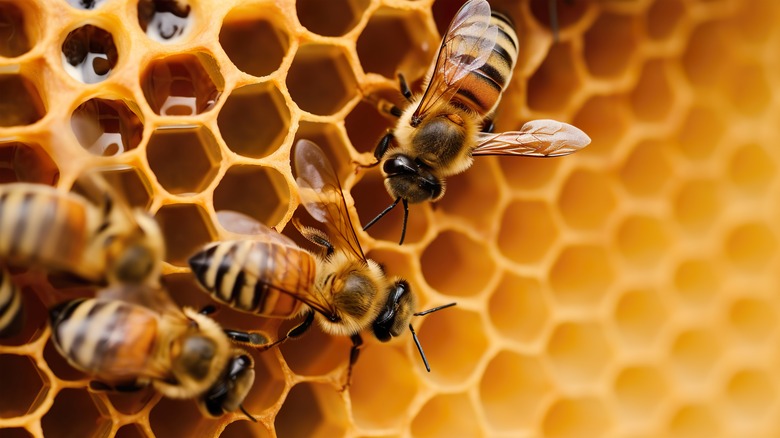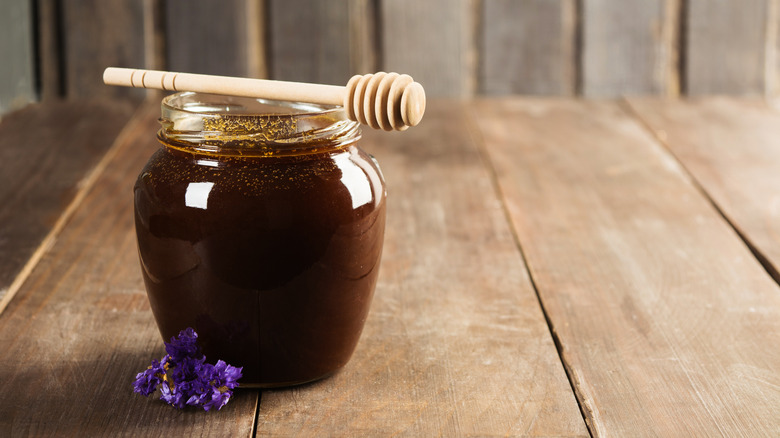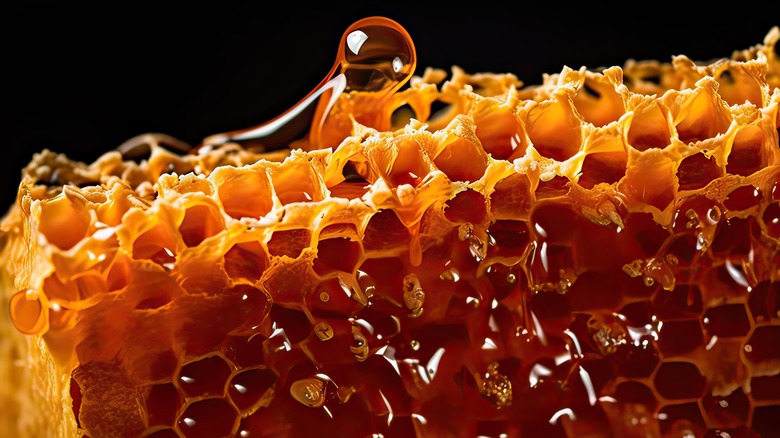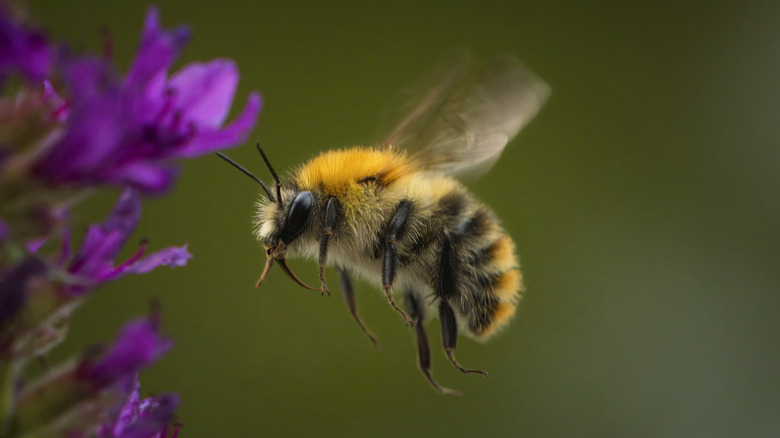False Facts About Honey You Thought Were True
Honey is produced by honey bees, which collect nectar from flowering plants using their proboscises, or elongated tongues, designed for sipping liquid. Once brought back to the hive, the nectar is processed and stored in honeycombs, gradually transforming into honey. Since bees usually produce more honey than they can consume, the excess can be collected from the hives for our culinary enjoyment.
Honey is utilized in a multitude of ways, reflecting its versatility. It's commonly used to sweeten tea and coffee, as well as in baking recipes. It can also be drizzled over Greek yogurt or oatmeal and used to elevate gourmet dishes. Additionally, honey is valued for its numerous health benefits, particularly when consumed raw. Considered by some as a superfood, in its unprocessed state, honey contains a variety of enzymes, vitamins, and minerals.
Honey has been around for millions of years, with the oldest records of beekeeping dating back to 7,000 B.C. Despite this long history, misconceptions about the natural sweetener continue to circulate both online and offline. Eager to discover the truth about this beloved golden syrup? Keep reading!
All honey is the same
Most grocery stores carry only a limited selection of honey, leading to the misconception that the available products represent the entire spectrum of honey options. However, what we see on supermarket shelves are usually brands that mass-produce honey, prioritizing consistency and cost-effectiveness over variety. As a result, shoppers tend to be exposed to jars of honey that are similar in flavor and appearance.
While this may not be readily apparent, honey comes in many different types, each distinguished by its source, color, taste, and aroma. According to the National Honey Board, the United States is home to 300 different honey varieties. Some of the more popular honey types include the light and mildly sweet clover honey, the clear and subtly flavored acacia honey, and buckwheat honey, which is known for its strong flavor and dark color. On the other end of the spectrum, there are plenty of rare kinds of honey that you're unlikely to find at your local grocery store. These include the dark, rich, and almost savory chestnut honey, the buttery and floral tupelo honey, and the thick and caramelly heather honey.
Honey is always organic
Just because honey is derived from the nectar of flowers by bees doesn't automatically qualify it as organic. While this process is indeed natural, it doesn't guarantee that the beekeeping practices that follow it adhere to the standards required for organic certification.
So what is organic honey? To cut a long story short, organic honey is produced from the nectar of plants that have grown without the use of fertilizers, pesticides, GMOs, and other chemicals. However, this can be hard to control since bees typically travel within a two-mile radius of the hive, which means that this area has to be free of any contaminants. While the USDA can certify honey as organic, the practice presents several challenges, as highlighted by the Wendell Estate. This is mainly due to the wide foraging range of bees and the need to ensure that every one of their sources is free from all prohibited substances.
When it comes to honey, the label "organic" doesn't automatically mean that the product is also pure, raw, and unfiltered. The "pure honey" label means that the product contains 100% honey, the "raw honey" label means that the product hasn't been pasteurized or heated above 118 degrees Fahrenheit, and the "unfiltered" label refers to the elimination of any tiny particles from the product, which sometimes involves heating. As such, it's important for shoppers to always read the product label before purchasing honey to ensure that it meets all their criteria.
Honey never spoils
Some might be surprised to learn that honey never expires if it's appropriately stored. In fact, in 1922, archeologists found a container with 3,000-year-old honey in the Tomb of Tutankhamun, and it was still edible! Honey's immortality can be attributed to two of its natural properties — low moisture content and high acidity. Furthermore, when flower nectar is converted into honey, bees infuse it with an enzyme that produces hydrogen peroxide, contributing to honey's antimicrobial properties and ultra-long shelf life.
The fact that honey doesn't have an expiration date doesn't mean that it will never go bad. According to the USDA, honey will start degrading in quality after 12 months, and while it will remain safe to eat, its flavor, aroma, and texture may diminish over time. Nevertheless, if honey comes into contact with moisture or isn't kept in an air-tight container, it's likely to spoil. For this reason, it's important to only use dry and clean utensils when scooping honey. Any signs of mold or an off smell mean that the honey has been contaminated and needs to be discarded.
Crystallization is a sign that the honey has gone bad
Honey crystallizes due to its glucose and fructose content, two sugars that form crystals when they separate. More specifically, the fructose in honey rises to the surface while the glucose crystallizes and sinks to the bottom. Typically, this process also thickens the honey's texture, while high-glucose honey types tend to be denser and more prone to rapid crystallization.
The rate of crystallization depends on various factors, including the honey's ratio of glucose to fructose, whether it contains pollen, and its storage temperature. Honey with high glucose levels tends to crystallize faster. Unfiltered honey that contains pollen is also likely to change consistency more rapidly than a filtered product. Finally, honey stored below 50 degrees Fahrenheit will crystallize faster than any stored at room temperature
While crystallized honey might look unsightly, the change in texture doesn't affect its flavor or quality. Crystallized honey is perfectly safe to eat, and in some cases, you may prefer it for its spreadable consistency. Moreover, crystallization can be easily reversed by gently warming the honey — this will turn the pantry staple into liquid without compromising its integrity and nutritional content.
Honey should never come in contact with metal spoons
One of the most curious misconceptions about honey is the idea that it should be kept away from metal utensils. This belief suggests that using metal spoons or containers could somehow taint the honey or alter its properties. More specifically, some people believe that the acidic properties of honey might corrode metal, leading to contamination and a change in the product's flavor.
Individuals who hold the belief that metal can affect honey are overlooking the fact that not all metals are the same. Generally, using spoons made of copper or iron to scoop out honey is not recommended, as these metals can alter the honey's flavor, and copper has the potential to make the honey toxic. On the other hand, both silver and stainless steel spoons are nonreactive and perfectly safe to use with honey. In fact, it's a common practice among beekeepers to utilize stainless steel tools and equipment during the honey production process. However, if you're still worried about potential interactions between metal and honey, the safest option is to use a wooden spoon.
All bees produce honey
Since honey is such a widely consumed product, people often generalize that all bees must produce honey. This, however, couldn't be further from the truth. In reality, of the 20,000 or so bee species, only around 4%, produce the golden nectar. In addition, only 8% of bees are social in that they live in communal hives. Notably, none of the 4,000 species of bees native to the U.S. produce honey. Instead, all of the country's honey-producing bees were introduced to the country by Europeans.
While there are thousands of bee types, only one type produces honey — the honey bee, or the genus Apis, an umbrella category for several bee species. Honey bees collect nectar from flowers, convert it into honey through a regurgitation process, and store it in wax honeycombs within their hives. These honey stores are a crucial food source for the colony, particularly during winters when resources may be scarce. Since bees usually make between double and triple the amount of honey required for their survival, we are lucky enough to enjoy the surplus.
Hot honey is poisonous
The belief that honey becomes toxic when heated is rooted in misconceptions about the nectar's characteristics and how it reacts to heat. While the precise source of this myth is uncertain, it might have arisen from the Ayurvedic belief that honey becomes toxic when heated above a certain temperature. It could also have something to do with the fact that honey isn't recommended for children under 12 months of age, owing to the small risk that it may contain botulism spores.
While heating honey may change its composition, consuming warm honey won't kill you or make you unwell. High temperatures can degrade honey's natural enzymes, vitamins, and minerals, diminishing its nutritional value and health benefits. Heat can also affect the honey's flavor. This said, heating honey to 95 degrees Fahrenheit won't reduce any of its health benefits, given that beehives sometimes also reach this temperature. In fact, warming honey is an excellent method of making crystallized honey more manageable by turning it into liquid.
Light honey is better than dark honey
Honey ranges in shade from almost colorless to dark amber. The main difference between light and dark honey lies in the floral sources from which the nectar is collected, not in the method it's produced. The color of honey can also depend on the season and temperature. For instance, honey may become darker when kept in warm conditions. The color of honey is evaluated in millimeters using the Pfund scale, where the lightest honey color is "water white" at 0 to 8 millimeters and the darkest is "dark amber," measuring between 115 and 140 millimeters.
While the color of honey can affect its quality and taste, this doesn't mean that light honey is superior to its darker counterpart. In fact, dark honey tends to have more antioxidants, vitamins, and minerals than light honey. For example, according to a research paper published in the Science Daily, dark buckwheat honey has 20 times the amount of antioxidants found in regular light honey. Dark honey also has a lower water content than light honey, making it more potent, richer in flavor, and thicker in texture.
Raw honeycombs aren't edible
Consisting of hexagonal cells made from beeswax, raw honeycombs are produced by bees to store their honey. The honey housed within these structures is considered raw since it hasn't been heated or processed. Concerns regarding the edibility of raw honeycombs often stem from their beeswax content.
Although the wax in honeycombs can make the honey chewier, it's completely safe to eat. Moreover, the unprocessed nature of raw honey ensures that you're making the most out of its health benefits when consuming it directly from the honeycomb. Raw honey also frequently contains bee pollen, royal jelly, and propolis, all known for their health benefits. Conversely, store-purchased honey is often heated and filtered, which reduces its enzyme content.
Raw honeycombs can be consumed in a variety of ways. The most straightforward way is to eat them on their own. Raw honeycombs can also be spread on toast, enjoyed as a part of a cheese platter, or used as a topping in salads. Adding raw honeycomb to yogurt or oatmeal is another delicious option since its sweetness can complement the creaminess of the yogurt or add flavor to the oats.
People allergic to bees are also allergic to honey
Since honey is a product made by bees, there's a natural assumption that the sweet nectar and bee stings might have similar allergenic properties. In reality, although bee stings can pose severe risks to individuals allergic to their venom, honey consumption generally does not trigger such issues. This is because honey is completely unrelated to the bee's stinger and venom sac. Instead, the pantry staple goes through the bee's digestive system, which doesn't contain any of the proteins that make bee venom dangerous to some individuals.
Despite this, some unfortunate individuals are still allergic to honey. However, this is very rare, affecting only 0.001% of the population. Those who experience allergic reactions to honey are often affected by the pollen that can be present in the sweet nectar. Symptoms of a honey allergy can vary and may include a runny nose, watery eyes, itchy throat, rash, and hives.
